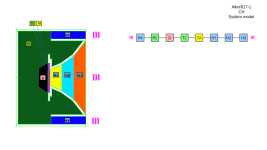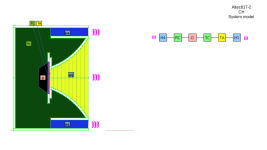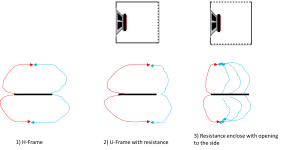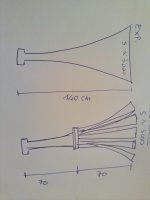I don't know the source of the Hornresp design shown, but the Altec horn should be modelled as a single exponential flare segment, rather than being approximated by multiple parabolic segments.
There are 2 models available and the results are basically the same.
Altec 817-1 - The model split the horn into 3 small parabolic flares
Altec 817-2 - The model take into account one single exponential flare
While building, parabolic should be easier, but for reverse engineering, he needs to choose the one and adjust size according to the box he has available.
Attachments
I would like to have more details about Ap1, Lp, Vtc, Atc?
See the picture on the post #13661
This box has 2 vents, one on each side, so to model we combine those 2 vents into a single and bigger one.
Once the model uses CH model from Hornresp (Compounded Horn) the vent model is defined from the Segment H4, so the throat and mouth from this segment needs to be equal.
The model spreadsheet has equations that you can look into it to see how each parameter is calculated.
OB Feature request:
Hello David,
In the attached picture, 1)H-Frame , 2) U-Frame are already implemented. I think the same logic can be extended to 3)resistance enclosure with "leaky" sides.
Such a model can be a more general model, and help balance directivity and sensitivity. I suspect that the feature can be implemented with existing code.
Thanks,
Giri
Hello David,
In the attached picture, 1)H-Frame , 2) U-Frame are already implemented. I think the same logic can be extended to 3)resistance enclosure with "leaky" sides.
Such a model can be a more general model, and help balance directivity and sensitivity. I suspect that the feature can be implemented with existing code.
Thanks,
Giri
Attachments
In the attached picture, 1)H-Frame , 2) U-Frame are already implemented. I think the same logic can be extended to 3)resistance enclosure with "leaky" sides.
Hi Giri,
The resistive termination U-frame model used in Hornresp was kindly provided by bolserst.
I suspect that a "resistive side" enclosure model could be much more difficult to develop.
Kind regards,
David
Hello David,
My thinking was that it's a matter of adding additional 'n' number of opposite phase sources at time delays of t/n, 2t/n......t. Where t is time delay for the farthest point etc.
Thanks for the reply.
Giri
Hello David,
Recently, when attempting to open the software, I came across an error message that reads: "Hornresp cannot find 'MS Sans Serif'." However, I would like to emphasize that I have the 'MS Sans Serif' font installed on my computer. Despite this, the error persists and prevents me from using Hornresp as intended.
Recently, when attempting to open the software, I came across an error message that reads: "Hornresp cannot find 'MS Sans Serif'." However, I would like to emphasize that I have the 'MS Sans Serif' font installed on my computer. Despite this, the error persists and prevents me from using Hornresp as intended.
Hi Gabriel,
Welcome to diyAudio!
A number of messages on this thread refer to the problem you describe. Hopefully they might be of some help.
Please search the Hornresp thread for references to ms sans serif, as shown in the attachment.
Sorry I can't be of more assistance - my knowledge of such things is very limited indeed!
Kind regards,
David
Welcome to diyAudio!
A number of messages on this thread refer to the problem you describe. Hopefully they might be of some help.
Please search the Hornresp thread for references to ms sans serif, as shown in the attachment.
Sorry I can't be of more assistance - my knowledge of such things is very limited indeed!
Kind regards,
David
Attachments
My thinking was that it's a matter of adding additional 'n' number of opposite phase sources at time delays of t/n, 2t/n......t.
I suspect it's likely to be a bit more complicated than that
Recently, when attempting to open the software, I came across an error message that reads: "Hornresp cannot find 'MS Sans Serif'."
The good news is that Gabriel managed to find the missing font. For some reason, it doesn't come pre-installed in Windows 10.
That's interesting. Because I am running windoz 10 and I never installed the font.The good news is that Gabriel managed to find the missing font. For some reason, it doesn't come pre-installed in Windows 10.
Hi!
I'm new to Hornresp and I have a question:
Is it possible to export the horn design to CSV or xls format?
What I would like is the horn as a table with horn Area, radius or diameter as a function of distance from the horn throat (or mouth I can always invert it).
Is there such an export function?
Sorry if this is of topic, I didn't find a specific forum for Hornresp so I figured this thread was a collection of questions for the program?
I'm new to Hornresp and I have a question:
Is it possible to export the horn design to CSV or xls format?
What I would like is the horn as a table with horn Area, radius or diameter as a function of distance from the horn throat (or mouth I can always invert it).
Is there such an export function?
Sorry if this is of topic, I didn't find a specific forum for Hornresp so I figured this thread was a collection of questions for the program?
It is possible to export the horn data as a .txt file, which can then be converted to .csv and then imported into Excel (or other software).
The export function is available from Window-->Schematic Diagram then go to File -->Export-->Horn Data.
Choose the type of profile among those available (rectangular etc.) and export data. You can preview the profile before exporting.
Several CAD softwares have a function (or plugin) to import .csv values as points which you can connect to ricreate the profile.
The export function is available from Window-->Schematic Diagram then go to File -->Export-->Horn Data.
Choose the type of profile among those available (rectangular etc.) and export data. You can preview the profile before exporting.
Several CAD softwares have a function (or plugin) to import .csv values as points which you can connect to ricreate the profile.
I wonder if there is a function in hornresp which will allow to model multicell horns as an array of multiple exponential horns. There is a function to calculate multiple drivers on a single horn but not for an array of multiple horns, AFAIK.
Here's a question which is not strictly hornresp related, but since all the horn designers are on this thread I will post it here and hopefully Kolbrek or someone else will chime in on the subject.
Would it be possible to model a multicell horn based on a standard exponential horn lenght and mouth surface ?
The idea would be to design a long (circa 70cm) "adapter" (the part connecting the driver to the multicell) and a 70 cm long multicell horn with a mouth of about 3000 square cm.
This would be aimed at designing a horn where the lenght and mouth surface are derived from a previously designed and optimized exponential horn with cutoff frequencies of 100hz and 2000hz.
The multicell "half" of the horn would be aimed at improving the dispersion vs the standard exponential, which would probably be quite "beamy" at the higher frequencies.
Think of it as some kind of sectoral horn where the sectors are replaced by multicells.
I attach a VERY ROUGH sketch for explanatory purposes.
Would this be worth further development or is it just a bad idea ?
Here's a question which is not strictly hornresp related, but since all the horn designers are on this thread I will post it here and hopefully Kolbrek or someone else will chime in on the subject.
Would it be possible to model a multicell horn based on a standard exponential horn lenght and mouth surface ?
The idea would be to design a long (circa 70cm) "adapter" (the part connecting the driver to the multicell) and a 70 cm long multicell horn with a mouth of about 3000 square cm.
This would be aimed at designing a horn where the lenght and mouth surface are derived from a previously designed and optimized exponential horn with cutoff frequencies of 100hz and 2000hz.
The multicell "half" of the horn would be aimed at improving the dispersion vs the standard exponential, which would probably be quite "beamy" at the higher frequencies.
Think of it as some kind of sectoral horn where the sectors are replaced by multicells.
I attach a VERY ROUGH sketch for explanatory purposes.
Would this be worth further development or is it just a bad idea ?
Attachments
I calculated my multicellular horn using Hornresp. I modeled the horn as exponential with required cutoff. Then I divided the area at the throat and mouth by the number of cells wanted - entered that into another Hornresp record with the same length and cutoff and exported the cell shape.
Pelanj, I understand your approach. I think the way you did it, you only used hornresp to "draw" the small horns, without possibility to analyze the result as an array. Is this correct ?
Perhaps you assume that dividing the large exponential info an x number of smaller ones makes no difference ?
Also, due to the lenght of the horn and small size of the throat compared to what required by the multicellular, I can only start the multicell.design at about half of the overall lenght, and not sure how this reflects on the overall performance (internal resonances ?).
Perhaps you assume that dividing the large exponential info an x number of smaller ones makes no difference ?
Also, due to the lenght of the horn and small size of the throat compared to what required by the multicellular, I can only start the multicell.design at about half of the overall lenght, and not sure how this reflects on the overall performance (internal resonances ?).
with the schematic diagram of the horn model displayed "file>export >horn data" looks to provide horn data in txt or csv, though I haven't used csv yet. The help file provides further details.Is there such an export function?
Because I am running windoz 10 and I never installed the font.
Thanks Mark, that is indeed interesting. It would seem that Gabriel must have had a different setup somehow.
"file>export >horn data" looks to provide horn data in txt or csv
Select txt or csv from drop down list:
Perhaps you assume that dividing the large exponential info an x number of smaller ones makes no difference ?
The power response should be effectively the same.
The pressure response will be different due to the different directivity characteristics of the multicell system.
I can only start the multicell.design at about half of the overall lenght, and not sure how this reflects on the overall performance (internal resonances ?).
The power response should be effectively the same.
I modeled the horn as exponential with required cutoff. Then I divided the area at the throat and mouth by the number of cells wanted - entered that into another Hornresp record with the same length and cutoff and exported the cell shape.
The above process can be used when the horn has an exponential flare. In other cases it may be necessary to construct the cell profile using the total areas at given points along the axis, divided by the number of cells.
With an exponential profile, if the throat area, mouth area and length of a single cell are entered, then the flare cutoff frequency of that cell will be the same as for the total system. This is not necessarily the case for other profiles.
- Home
- Loudspeakers
- Subwoofers
- Hornresp




